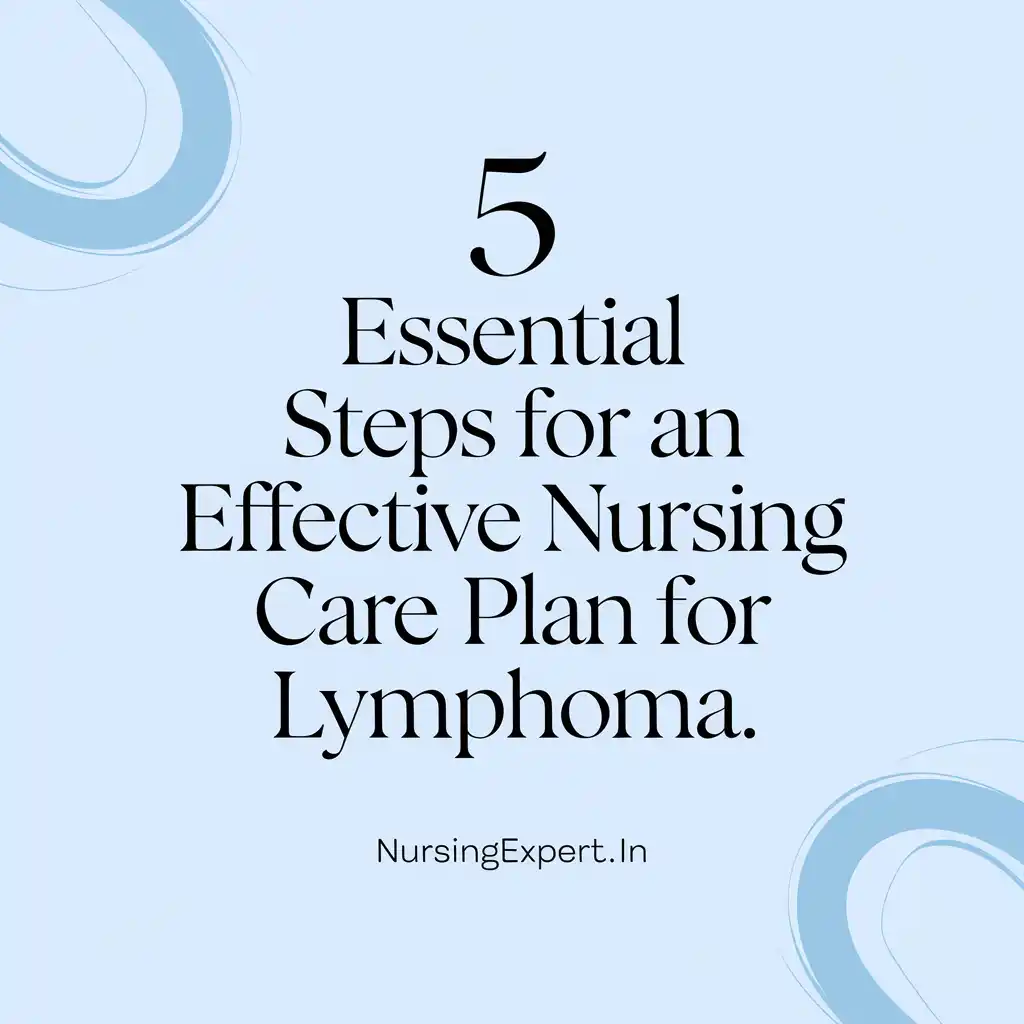Introduction
Lymphoma is a type of cancer that affects the lymphatic system, which is vital for the body’s immune defense. It includes different subtypes such as Hodgkin’s lymphoma and Non-Hodgkin’s lymphoma. Patients with lymphoma face unique challenges that require careful and coordinated nursing care. A structured nursing care plan provides a step-by-step guide to assess, diagnose, plan, implement, and evaluate care. Using an evidence-based approach ensures that each patient receives safe, effective, and individualized care. This article explains five essential steps to create a nursing care plan for lymphoma and includes sample care plans. You can download the free PDF to have a detailed reference at their fingertips.
Thank you for reading this post, don't forget to subscribe!
In this guide, we break down the process into simple steps and explain the rationale behind each intervention. Our goal is to help you build a comprehensive care plan that not only addresses the physical aspects of lymphoma but also supports the emotional and educational needs of your patients. Whether you work in an oncology unit or support outpatient care, this article provides clear guidance for optimal nursing management of lymphoma.
I. Understanding Lymphoma
A. What Is Lymphoma?
Lymphoma is a cancer of the lymphatic system. This system comprises lymph nodes, the spleen, the thymus gland, and bone marrow. Lymphoma is broadly classified into two main types:
- Hodgkin’s Lymphoma (HL): Characterized by the presence of Reed-Sternberg cells, HL most often affects young adults and has a relatively high cure rate.
- Non-Hodgkin’s Lymphoma (NHL): This category includes a diverse group of cancers that vary in aggressiveness and treatment. NHL generally occurs in older adults, although it can affect all age groups.
B. Causes and Risk Factors
While the exact cause of lymphoma remains unclear, several factors can increase the risk:
- Genetic Factors: A family history of lymphoma can predispose an individual to the disease.
- Immune System Dysfunction: Conditions like HIV/AIDS or immunosuppressive therapy after organ transplantation can elevate lymphoma risk.
- Viral Infections: Epstein–Barr virus (EBV) and human T-cell lymphotropic virus (HTLV-1) are linked to certain types of lymphoma.
- Environmental Exposures: Long-term exposure to chemicals or pesticides may contribute.
- Age and Gender: Some subtypes have higher incidence in particular age groups and may be more common in one gender.
C. Signs and Symptoms
Patients with lymphoma may experience a variety of symptoms that can be vague and nonspecific. Common signs and symptoms include:
- Lymphadenopathy: Painless swelling of lymph nodes, often in the neck, armpit, or groin.
- B Symptoms: Fever, night sweats, and unintentional weight loss.
- Fatigue: Persistent tiredness that interferes with daily activities.
- Other Symptoms: Itching, cough, or shortness of breath if mediastinal lymph nodes are involved.
Accurate assessment of these symptoms is critical to developing an effective care plan.
II. Importance of a Nursing Care Plan for Lymphoma


A nursing care plan is a written document that outlines a systematic approach to patient care. For lymphoma, it serves several important functions:
A. Ensuring Consistent and Evidence-Based Care
A well-developed care plan ensures that all healthcare providers follow the same evidence-based guidelines. This consistency improves patient safety and leads to better outcomes.
B. Promoting Communication and Coordination
Lymphoma care often involves a multidisciplinary team. A nursing care plan helps coordinate efforts among nurses, oncologists, pharmacists, dietitians, mental health professionals, and other team members.
C. Enhancing Patient Education and Self-Care
Patients with lymphoma benefit from clear education about their condition and treatment. A care plan includes strategies for teaching patients how to manage symptoms, adhere to medication regimens, and adopt lifestyle modifications that support recovery.
D. Providing a Framework for Monitoring and Evaluation
Setting measurable goals and outcomes allows nurses to track patient progress. Regular evaluation helps in adjusting the plan when necessary, ensuring that interventions remain effective over time.
E. Reducing Patient Anxiety
Facing a cancer diagnosis can be overwhelming. A clear and structured care plan reassures patients and helps them understand each step of their treatment journey, thereby reducing anxiety.
III. Five Essential Steps to an Effective Nursing Care Plan for Lymphoma
Creating a nursing care plan for lymphoma involves a systematic process. Here, we outline five essential steps.
Step 1: Assessment
Thorough assessment is the foundation of a successful care plan. It involves gathering both subjective and objective data.
A. Collecting Subjective Data
Ask the patient about their experiences:
- “What symptoms have you noticed?”
- “How do you feel physically and emotionally?”
- “What concerns do you have about your treatment?”
Record the patient’s descriptions of pain, fatigue, weight loss, night sweats, and any other relevant symptoms. This personal insight is crucial for tailoring the care plan.
B. Collecting Objective Data
Perform a detailed physical examination:
- Vital Signs: Measure temperature, heart rate, and blood pressure.
- Lymph Node Examination: Palpate lymph nodes to assess for swelling, tenderness, and consistency.
- Laboratory Tests: Review blood tests (e.g., CBC, LDH, beta-2 microglobulin) and imaging studies (CT, PET scans) to determine disease extent.
- Nutritional Status: Monitor weight changes and nutritional intake.
Use standardized assessment tools when available. Document all findings clearly.
Step 2: Nursing Diagnosis for Lymphoma
Develop a nursing diagnosis that captures the patient’s main issues. Use standard language from NANDA-I to maintain clarity.
A. Examples of Nursing Diagnoses for Lymphoma
- Ineffective Health Maintenance related to lack of knowledge about the disease process as evidenced by patient questions and uncertainty regarding treatment.
- Impaired Immune Response related to chemotherapy and the lymphoma process as evidenced by recurrent infections and fatigue.
- Acute Pain related to treatment side effects as evidenced by patient verbalizations and observations of discomfort.
- Anxiety related to fear of disease progression and treatment outcomes as evidenced by expressions of worry and physiological signs of distress.
Step 3: Goal Setting and Expected Outcomes
Set clear, measurable, and achievable goals. Outcomes should address both physical and emotional needs.
A. Example Goals
- Short-Term Goal: The patient will verbalize understanding of their lymphoma diagnosis and treatment plan within 48 hours.
- Long-Term Goal: The patient will demonstrate improved nutritional status and maintain stable weight during treatment.
- Emotional Goal: The patient will report decreased anxiety levels and participate in supportive counseling sessions as scheduled.
Ensure goals are patient-centered and based on the assessment findings.
Step 4: Planning and Interventions for Lymphoma
Plan interventions that directly address the identified nursing diagnoses and help achieve the set goals.
A. Evidence-Based Interventions
- Patient Education:
- Provide clear explanations about lymphoma, treatment options, and potential side effects.
- Use printed materials and visual aids to support learning.
- Symptom Management:
- Administer prescribed medications for pain and side effects.
- Implement nutritional support measures by involving a dietitian.
- Psychosocial Support:
- Encourage the patient to express concerns and feelings.
- Arrange for counseling sessions and support group referrals.
- Monitoring:
- Schedule regular assessments of vital signs, weight, and laboratory values.
- Monitor for complications such as infection, anemia, and respiratory distress.
- Interdisciplinary Coordination:
- Collaborate with oncologists, pharmacists, and other team members to ensure cohesive care.
- Document and communicate all interventions and patient responses clearly.
Step 5: Implementation and Evaluation for Lymphoma
Execute the planned interventions and continually evaluate the patient’s progress.
A. Implementation
- Begin by delivering patient education sessions. Explain the disease and treatment process in clear, simple terms.
- Administer medications, provide nutritional support, and set up psychosocial interventions as planned.
- Record each step of the intervention and any patient responses.
B. Evaluation
- Reassess vital signs, lab results, and symptom reports.
- Use tools such as patient self-report and standardized scales to measure progress.
- Compare current data with expected outcomes to determine if goals are met.
- Adjust the care plan if necessary based on ongoing evaluation and patient feedback.
IV. Sample Nursing Care Plan for Lymphoma
Below are five sample Nursing care plans for lymphoma. These examples provide a structured view of assessment, nursing diagnosis, goals, interventions, implementation, rationale, and evaluation.
| Assessment | Nursing Diagnosis | Goal/Expected Outcome | Intervention/Planning | Implementation | Rationale | Evaluation |
|---|---|---|---|---|---|---|
| Patient reports fatigue, weight loss, and night sweats; palpable, painless lymphadenopathy noted. | Ineffective Health Maintenance related to lack of knowledge about lymphoma as evidenced by patient uncertainty regarding treatment. | Patient will explain lymphoma diagnosis and treatment plan in simple terms within 48 hours. | Provide patient education using visual aids and printed materials; schedule a Q&A session. | Conduct a bedside education session; review brochures and answer questions. | Improved knowledge leads to better self-care and treatment adherence. | Patient verbalizes understanding and correctly explains their care plan. |
| Patient exhibits pain and discomfort due to treatment side effects, including nausea and mucositis. | Acute Pain related to chemotherapy-induced mucositis as evidenced by patient reports of severe throat pain and difficulty swallowing. | Patient will report a decrease in pain from 8/10 to 4/10 within 24 hours after interventions. | Administer analgesics as prescribed; instruct in deep breathing and relaxation techniques; offer soft foods and hydration support. | Give scheduled pain medication; assist with deep breathing exercises; monitor intake and output. | Effective pain management enhances recovery and comfort. | Patient reports lower pain scores and improved ability to eat and drink. |
| Patient experiences anxiety about treatment outcomes and future uncertainties. | Anxiety related to fear of disease progression as evidenced by restlessness, rapid pulse, and verbal expressions of worry. | Patient will identify two coping strategies and report decreased anxiety within 48 hours. | Provide supportive counseling; teach coping techniques such as guided imagery and mindfulness; involve family support. | Schedule a session with the counseling team; practice guided imagery together. | Coping techniques reduce physiological stress and enhance emotional well-being. | Patient demonstrates use of coping strategies and reports lower anxiety levels. |
| Patient shows signs of nutritional deficit, including weight loss and decreased appetite. | Imbalanced Nutrition: Less Than Body Requirements related to decreased appetite and treatment side effects as evidenced by weight loss and reduced caloric intake. | Patient will increase daily caloric intake and maintain or gain weight within one week. | Collaborate with a dietitian; plan small, frequent meals with high protein; monitor weight daily. | Provide nutritional counseling; arrange dietitian consultation; track weight and intake. | Adequate nutrition supports healing and energy levels during treatment. | Patient’s weight stabilizes and nutritional intake improves per daily records. |
| Patient exhibits signs of infection risk due to immunosuppression from chemotherapy. | Risk for Infection related to impaired immune function as evidenced by low white blood cell count and history of fever. | Patient will remain free from signs of infection during hospitalization and post-discharge follow-up. | Monitor temperature and WBC counts; educate on hand hygiene and infection prevention; administer prophylactic antibiotics if ordered. | Record vital signs every 4 hours; instruct on proper hygiene; liaise with the medical team for antibiotic therapy. | Preventing infection is critical in immunosuppressed patients to avoid complications. | No signs of infection; normal temperature and laboratory values maintained. |
V. Detailed Discussion of Nursing Interventions for Lymphoma
A clear explanation of each intervention and its rationale helps ensure that every action is evidence-based and patient-centered.
A. Patient Education and Health Teachings
Educating patients about lymphoma is crucial. Nurses explain the disease, treatment options, and self-care strategies using clear language. This information reduces anxiety and empowers patients to participate in their care. Written materials, visual aids, and one-on-one sessions can be used effectively.
B. Symptom Management and Pain Control
Managing side effects is vital for patient comfort. Nurses must monitor pain levels and administer medications accordingly. Techniques such as deep breathing and guided imagery can supplement pharmacologic interventions, improving patient comfort and reducing stress.
C. Nutritional Support
Patients with lymphoma often experience weight loss and poor appetite. A collaborative approach involving dietitians ensures that patients receive a balanced diet rich in calories and protein. Monitoring weight, encouraging small frequent meals, and addressing gastrointestinal discomfort are key components of nutritional support.
D. Psychosocial and Emotional Support
A lymphoma diagnosis can lead to significant emotional distress. Nurses provide psychosocial support by listening, offering reassurance, and connecting patients with counseling services or support groups. Addressing emotional needs directly improves overall outcomes.
E. Infection Prevention
Due to compromised immunity, lymphoma patients are at increased risk of infection. Nurses implement strict infection control measures, including monitoring for fever, enforcing hand hygiene, and educating patients on preventive practices. Timely intervention when signs of infection appear is critical.
F. Interdisciplinary Collaboration
Lymphoma care involves a team of professionals. Regular communication between oncologists, pharmacists, dietitians, mental health providers, and nurses ensures that all aspects of care are addressed. Documentation and coordination of care help prevent treatment delays and improve overall quality.
VI. Frequently Asked Questions (FAQs)
FAQ 1: What is a Nursing Care Plan for Lymphoma?
A nursing care plan for lymphoma is a structured document that outlines the assessment, diagnosis, interventions, and evaluation steps required to manage patients with lymphoma. It uses evidence-based practices to address physical, nutritional, and emotional needs.
FAQ 2: Why should I download a Nursing Care Plan for Lymphoma PDF?
Downloading the PDF provides a ready-to-use resource that guides you through every step of care planning. It offers detailed strategies, sample care plans, and evidence-based interventions to improve patient outcomes.
FAQ 3: What are the key components of a lymphoma care plan?
Key components include a thorough assessment of symptoms, clear nursing diagnoses, measurable goals, specific interventions (such as patient education, nutritional support, and infection control), implementation strategies, and evaluation of outcomes.
FAQ 4: How do nurses monitor patients with lymphoma?
Nurses monitor patients by regularly checking vital signs, weight, laboratory values, and symptoms. They also assess nutritional status and psychosocial well-being to ensure early detection of complications and effective management of side effects.
VII. Conclusion
A well-structured nursing care plan for lymphoma is essential for delivering optimal patient care. By following the five essential steps—assessment, nursing diagnosis, goal setting, planning interventions, and ongoing evaluation—nurses can effectively manage lymphoma and its complications. The comprehensive guide provided in the free PDF download supports evidence-based practice, improves patient outcomes, and enhances interdisciplinary coordination. Use this resource to empower your practice and help patients navigate their treatment journey with confidence.
VIII. References and Sources
- Lymphoma Care Plan (PDF) – Lymphoma Research Foundation.
https://lymphoma.org/wp-content/uploads/2020/09/LRF-Care-Plan-Form_091620-1.pdf - Nurseslabs – Lymphoma Nursing Care Plans.
https://nurseslabs.com/lymphoma-nursing-care-plans/ - Nurse.com – Nursing Care Plan (NCP) for Lymphoma (Hodgkin’s, Non-Hodgkin’s).
https://nursing.com/lesson/nursing-care-plan-for-lymphoma-hodgkins-non-hodgkins - American Cancer Society – Lymphoma Overview.
https://www.cancer.org/cancer/lymphoma.html - Mayo Clinic – Lymphoma: Diagnosis and Treatment.
https://www.mayoclinic.org/diseases-conditions/lymphoma/diagnosis-treatment/drc-20352648


